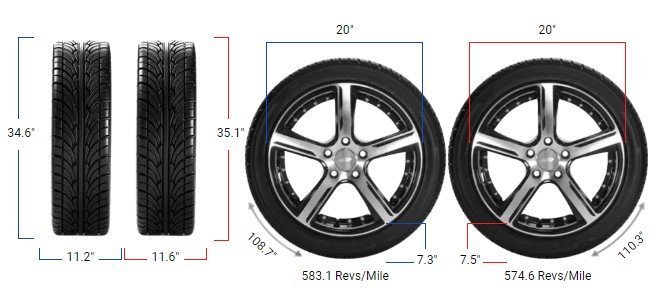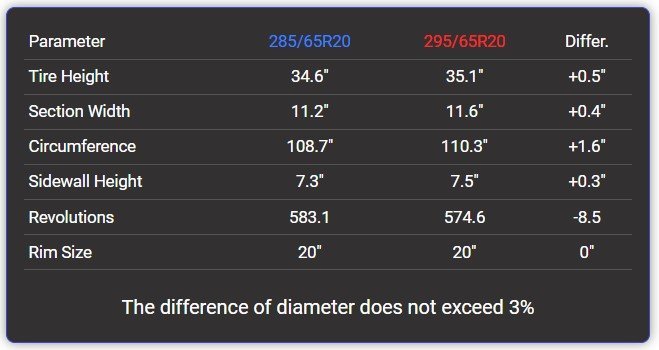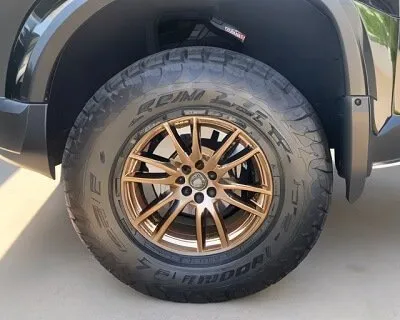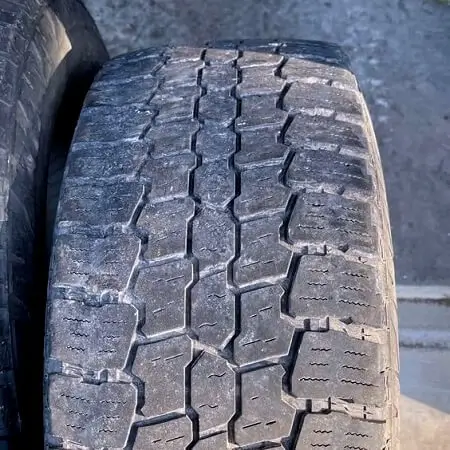Tire Size 285/65r20 vs 295/65r20
 The differences may seem minor, they can have surprising impacts on your vehicle’s performance, handling, and even fuel efficiency. Let’s take a closer look at what switching to 295/65R20 tires really means for your ride.
The differences may seem minor, they can have surprising impacts on your vehicle’s performance, handling, and even fuel efficiency. Let’s take a closer look at what switching to 295/65R20 tires really means for your ride.
- Improved traction and stability due to wider contact patch
- Slightly better ride comfort from taller sidewalls
- Minor reduction in fuel efficiency (about 1.5%)
- Speedometer will read about 1.5% slower than actual speed
- Aggressive aesthetic appeal of wider tires
285/65r20 vs 295/65r20

Fitment Guide
In this case, 295/65R20 tires are only 1.5% larger in diameter than 285/65R20 tires, which falls within the acceptable range.
This means that in most cases, you can use 295/65R20 tires without needing modifications to account for rubbing or clearance issues.
On-Road Impact
Upgrading to wider tires can enhance your vehicle’s on-road performance, but it’s not without trade-offs. Here’s what you can expect:
- Handling: The wider contact patch of 295/65R20 tires provides increased grip and stability, especially during cornering and in wet conditions. You may notice improved responsiveness and a sportier feel behind the wheel.
- Ride Comfort: The extra width of 295/65R20 tires means a larger sidewall, which can slightly improve ride comfort by better absorbing bumps and vibrations. However, the difference may be barely noticeable in real-world driving.
- Fuel Efficiency: Wider tires generally have increased rolling resistance, which can slightly reduce fuel efficiency. The 295/65R20 size has about 1.5% fewer revolutions per mile compared to 285/65R20, translating to a minor hit on gas mileage.
- Speedometer Accuracy: Due to the larger diameter, your speedometer will read about 1.5% slower with 295/65R20 tires. At 20 mph, your actual speed will be closer to 20.3 mph. Keep this in mind to avoid unintentional speeding.

Off-Road Impact
If you venture off the pavement, the switch to 295/65R20 tires can bring some advantages:
- Traction: The wider footprint of 295/65R20 tires allows for better traction on loose surfaces like sand, gravel, and mud. The extra width helps the tires float over soft terrain rather than digging in.
- Ground Clearance: With a 0.51-inch (13 mm) increase in overall diameter, 295/65R20 tires provide a slight boost in ground clearance. This can be helpful for navigating rocky trails or fording shallow water crossings.
- Durability: The taller, wider sidewalls of 295/65R20 tires offer more cushioning against impacts from rocks and roots. This can help prevent punctures and enhance overall durability in rugged off-road conditions.
- Aesthetics: For many, the muscular look of wider tires is part of the appeal. 295/65R20 tires will give your vehicle a more aggressive stance that hints at its off-road prowess.

What is the Main Difference Between 285/65r20 and 295/65r20?
The primary difference between 285/65R20 and 295/65R20 tires is the width. 295/65R20 tires are 0.39 inches (10 mm) wider than 285/65R20 tires, which can provide incremental improvements in traction, stability, and aesthetics.
Can I Use 295/65r20 Instead of 285/65r20?
Yes, in most cases you can use 295/65R20 tires instead of 285/65R20 without any modifications.
The overall diameter difference of 1.5% falls within the generally accepted range of 3% compared to the original tire size.

How Much Taller Is a 295/65r20 Tire Than a 285/65r20?
A 295/65R20 tire is 0.51 inches (13 mm) taller than a 285/65R20 tire. This translates to a 1.5% difference in overall diameter, which is minor but can slightly affect ground clearance and speedometer accuracy.
How Much Wider is a 295/65r20 Tire Than a 285/65r20?
A 295/65R20 tire is 0.39 inches (10 mm) wider than a 285/65R20 tire, which represents a 3.5% difference in width.
The wider footprint provides a larger contact patch for improved traction and stability.
Our Observations
After weighing the benefits and drawbacks, we believe switching from 285/65R20 to 295/65R20 tires offers incremental improvements for both on-road and off-road performance.
The increased width provides better stability, traction, and durability, while the taller sidewalls slightly enhance ride comfort and ground clearance.
However, it’s important to note that the differences are relatively minor – the 3.5% increase in width and 1.5% increase in diameter are barely perceptible in most driving situations. The slight reduction in fuel efficiency and speedometer accuracy are also negligible for most drivers.
Ultimately, the decision to upsize to 295/65R20 tires depends on your specific needs and preferences. If you frequently drive in wet or loose conditions, or simply prefer the look of wider tires, the switch may be worthwhile.
But if you’re primarily focused on maximizing fuel economy or don’t need the extra capability, sticking with 285/65R20 tires is perfectly acceptable.

Meet Caitlin McCormack, a Tire Size Expert and Blogger Passionate About Everything Related to Tires. With Years of Experience in the Tire Industry, Caitlin Has Become an Expert in Tire Sizes and Their Impact on Vehicle Performance.
